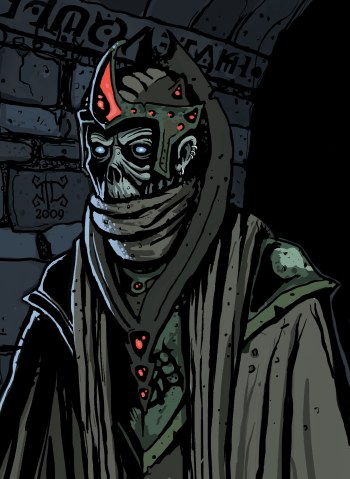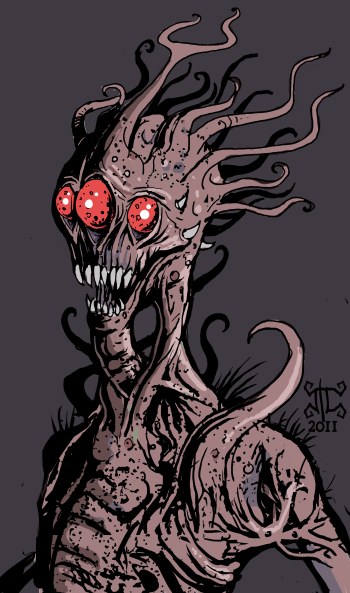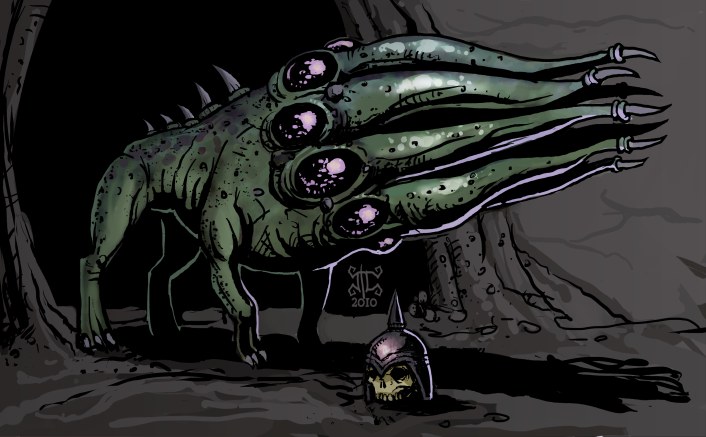|
Armor Category:
8 [11]
|
|
Monster Type:
Abomination
|
|
Health Dice:
4d8*
|
|
Outlook:
Malevolent Chaos
|
|
Movement:
100' (25')
|
|
No. Appearing:
Pack (1d4)
|
|
Morale:
9
|
|
Experience:
350xp
|
Attacks & Damage:
† Claws (2) 1d4 — † Bite 1d6
|
Special Attacks & Abilities:
→ Ranged Attack: The creature can hit you from a distance.
† Melee Attack: The creature needs to be adjacent to hit you.
♦ Defensive Ability: The creature has a special resistance or bonus to its defenses.
|
|
Treasure & Possessions: None
|
| AC [Desc] |
9 |
8 |
7 |
6 |
5 |
4 |
3 |
2 |
1 |
0 |
| To Hit |
8 |
9 |
10 |
11 |
12 |
13 |
14 |
15 |
16 |
17 |
| AC [Asc] |
10 |
11 |
12 |
13 |
14 |
15 |
16 |
17 |
18 |
19 |
| Toxin or Disease |
Magical Devices |
Ray or Gaze |
Blast or Breath |
Spells |
| 13 |
10 |
12 |
11 |
14 |
|
Overview
The MMP stat block included with each monster entry provides the basic information needed to run the monster in-game. The stats themselves are simple enough that converting them for use with your favorite vintage fantasy adventure game rules (such as Basic rules published in, say, 1981) should be fairly straightforward. I've also designed the block with retro-clone cross compatibility in mind.
One word of warning - I don't generally number crunch the stats too much (if at all, sometimes), so there are no guarantees of balance expressed or implied. If you have recommendations for stat changes, do let me know and I may alter them.
I came up with this basic stat block design a while back in an attempt to make an attractive, easy-to-read block that contains all the information needed to run a creature while minimizing rifling through books. It was an entertaining challenge in information design and I'm fairly happy with the result.
Main Stat Block
Armor Category (AC) – A measure of how difficult a creature is to hit. Two values are provided descending AC (lower is better) and ascending AC (in brackets; higher is better).
Health Dice (HD) – The number of eight sided dice (d8) rolled to generate the creature's health points (hp).
Movement – Distance in feet that a creature can move. The first number represents the amount of distance the creature can cover in a ten minute turn, while the second represents the distance covered per combat round.
Morale – The creature's morale. When checking morale, roll two six-siders (2d6). If a value higher than the morale score is rolled, the creature will flee. Creatures with morale of 12 will fight to the death, no exceptions.
Monster Type – The monster's general classification or family. Abomination and Undead are common examples of monster type.
Outlook – The monster's worldview, if it has one. Options are:
- Malevolent Order
- Malevolent Chaos
- Malevolent Opportunist
- Opportunist (if intelligent) -or- Bestial (if animalistic)
- Benevolent Opportunist
- Benevolent Chaos
- Benevolent Order
Experience – The number of experience points (XP) awarded for the defeat of the monster.
Attacks & Damage – The basic attacks available to the monster. Melee attacks are marked with a dagger (†), ranged attacks with an arrow (→).
Special Attacks & Abilities – Special combat or non-combat abilities the monster posesses. Melee abilities are marked with a dagger (†), ranged attacks with an arrow (→), and defensive or non-combat abilities with a diamond (♦).
To Hit Chart
Rather than having to look up combat values in a book, the combat chart is provided in the monster entry. The top row shows the target ascending AC value, the bottom row shows the target descending AC value and the center row shows the d20 roll needed to hit that value.
Saving Throw Chart
Saving throws are also provided in the monster entry. This eliminates looking up the value in a separate table and also allows the saving throws to be customized on a creature-by-creature basis.
Toxin or Disease – Use this when resisting poison, disease and instant death. In general, use this for anything that puts a creature's fortitude or endurance to the test.
Magical Devices – Use to resist the effects of magic wands and any other device that slings magic.
Ray or Gaze – Use this save when resisting the effects of paralyzing stares, ray-like breath weapons and other such effects. (Example: A medusa's gaze attack).
Blast or Breath – Explosions, fiery dragons' breath and other area effects. If you'd run away from it in slow motion in an action movie, this is the saving throw to use. In general, use for situations in which reflexes make a difference.
Spells – Use to resist the effects of spells, whether cast or read from a scroll. In general, use for attacks that require strong willpower to resist.
Other Monster Entry Notes
I've added some features to make the monster entries on this blog easy to print out and use at the table. I want to make sure that the monsters leave the confines of the website and make their way to gaming tables everywhere.
When you print a monster entry, the site header and most other extraneous stuff won't print, so you will get a page that consists solely of the monster entry, making it convenient for tossing into a folder or three ring binder.
Also, most images have both a color and black and white version which can be toggled by clicking on the image. If you want to save printer ink, or just want your monster entries in black and white, '70s style, then switch to the black & white version and print away! For true vintage RPG flavor, print them in black and white on pastel green or gold paper.
Also, note that there is no OGL content on this website. If you want to use any of the monsters from this site in a gaming product (whether for sale or not), please let me know.









